The AMD A8-7650K APU Review, Also New Testing Methodology
by Ian Cutress on May 12, 2015 10:00 AM ESTOffice Performance
The dynamics of CPU Turbo modes, both Intel and AMD, can cause concern during environments with a variable threaded workload. There is also an added issue of the motherboard remaining consistent, depending on how the motherboard manufacturer wants to add in their own boosting technologies over the ones that Intel would prefer they used. In order to remain consistent, we implement an OS-level unique high performance mode on all the CPUs we test which should override any motherboard manufacturer performance mode.
All of our benchmark results can also be found in our benchmark engine, Bench.
Dolphin Benchmark: link
Many emulators are often bound by single thread CPU performance, and general reports tended to suggest that Haswell provided a significant boost to emulator performance. This benchmark runs a Wii program that raytraces a complex 3D scene inside the Dolphin Wii emulator. Performance on this benchmark is a good proxy of the speed of Dolphin CPU emulation, which is an intensive single core task using most aspects of a CPU. Results are given in minutes, where the Wii itself scores 17.53 minutes.
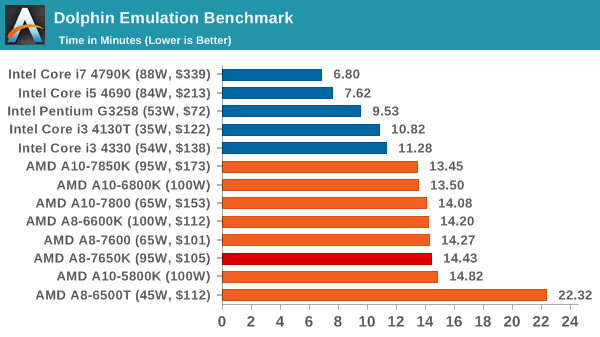
Dolphin likes high IPC and clock frequency, which indicates that the highest clocked APUs perform the best out of AMD here. Because the benchmark is single threaded, even a dual core Intel wins though.
WinRAR 5.0.1: link
Our WinRAR test from 2013 is updated to the latest version of WinRAR at the start of 2014. We compress a set of 2867 files across 320 folders totaling 1.52 GB in size – 95% of these files are small typical website files, and the rest (90% of the size) are small 30 second 720p videos.

The varied-thread workload of WinRAR seems to vary between the dual core Intels and the dual module AMD chips, showing that threads matter.
3D Particle Movement
3DPM is a self-penned benchmark, taking basic 3D movement algorithms used in Brownian Motion simulations and testing them for speed. High floating point performance, MHz and IPC wins in the single thread version, whereas the multithread version has to handle the threads and loves more cores.

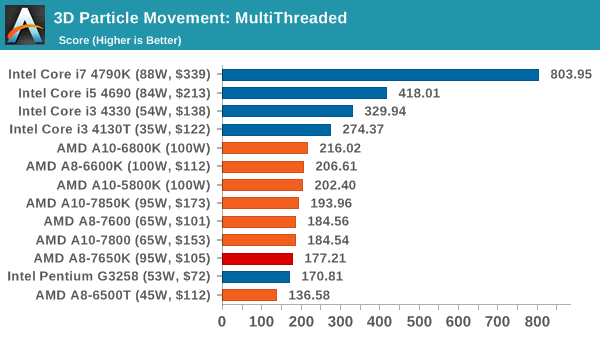
In this nieve benchmark, the compiler prefers x87 style commands which AMD's Bulldozer based architectures isn't too fond of. This benchmark is meant to be a representation of crude scientific code, similar to that used in a research lab. Ultimately, Bulldozer architectures such as Kaveri prefer specific commands, especially when dealing with basic math.
FastStone Image Viewer 4.9
FastStone is the program I use to perform quick or bulk actions on images, such as resizing, adjusting for color and cropping. In our test we take a series of 170 images in various sizes and formats and convert them all into 640x480 .gif files, maintaining the aspect ratio. FastStone does not use multithreading for this test, and results are given in seconds.
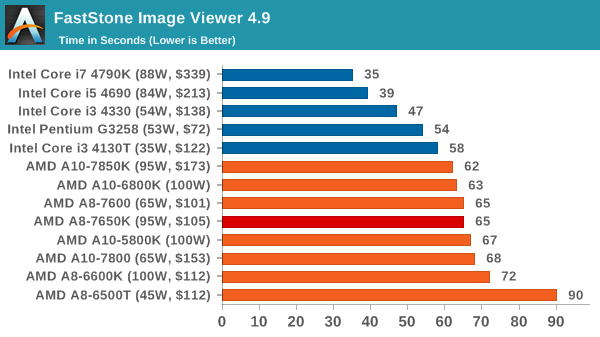
Web Benchmarks
On the lower end processors, general usability is a big factor of experience, especially as we move into the HTML5 era of web browsing. For our web benchmarks, we take four well known tests with Chrome 35 as a consistent browser.
Sunspider 1.0.2

Mozilla Kraken 1.1

WebXPRT
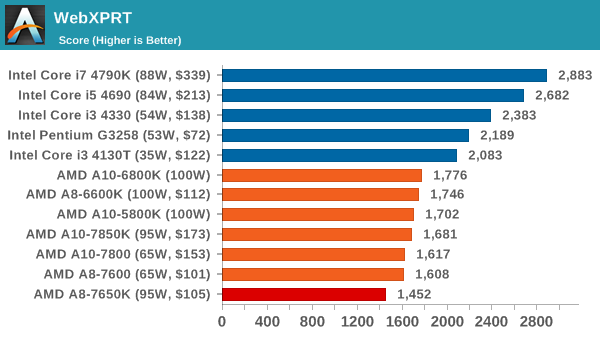
Google Octane v2
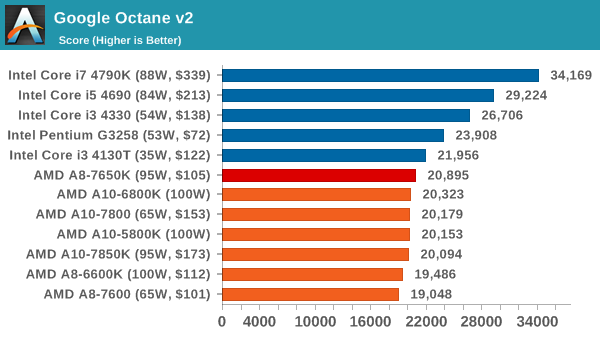










177 Comments
View All Comments
CPUGPUGURU - Tuesday, May 12, 2015 - link
AMD APU is a watt, money, time wasting bottlenecking inferior choice that there is next to no market for, for AMD fusion was and still is a delusion. Intel's world class IPC performance, node process and a dGPU are a MUCH BETTER investment.Intel's APU's performance advantage makes them a wise choice for the Tablet, Convertible, or Ultrabook market, I'm looking forward to a Surface Skylake to go mobile with.
mayankleoboy1 - Tuesday, May 12, 2015 - link
Ian, this is probably the 3rd or 4th testing methodology/benchmark changes that you have seen during AT. My question is:Do you think that Multithreading is *really* more mainstream now? As in, do most general purpose softwares use more than 2 cores?
Ian Cutress - Tuesday, May 12, 2015 - link
The way I like to think about it is that even if software only uses one core, I like to have many on the go at the time. Chrome tabs are a nice example.But multithreading is now being taught in some CS undergraduate classes, meaning that at least it's slowly entering the software ecosystem as default knowledge, rather than as an afterthought. In my opinion, that's always been a big barrier to multithreading (as well as having parallelizable code).
Another thought is consider the software you use. Is it made by a big multinational with a strong software development team? If yes, chances are it is multithreaded. If it uses a big commercial engine, it probably is as well. If it's based on a small software team, then it more likely isn't.
-Ian
V900 - Tuesday, May 12, 2015 - link
Multithreading being taught at CS classes today doesnt matter much.It's not like multithreading is some unknown new technology we can't take advantage of. Dual/quad core processors have been common for over a decade.
OS X have Grand Central Despatch. Windows 7/8 can take advantage of multithreading.
The problem is that it's not all tasks on a computer/in an operating system that does benefit from multithreading.
And that's not going to change. Otherwise we wouldn't see AMD going back to the drawing board and throwing the module-concept in the trash in order to focus on single thread performance like in the Zen CPU.
So unless you know you need it today, multithreading performance is a lousy parameter to choose a CPU from, cause it won't get better in the future.
ppi - Tuesday, May 12, 2015 - link
But now, how many real tasks, where CPU is the real bottleneck ...... and not GPU, storage, internet connection, or gasp ... the user ...
.. and such task is not multithreaded on reasonably written software?
Oxford Guy - Sunday, May 17, 2015 - link
According to rumor you mean.ToTTenTranz - Tuesday, May 12, 2015 - link
Why does Anandtech keep refusing to test lower performance CPUs and APUs with Mantle-enabled games?Those should be a great way to predict the advantages of lower CPU overhead in DX12 and Vulkan.
CPUGPUGURU - Tuesday, May 12, 2015 - link
BECAUSE Mantle is AMD ONLY and DX12/Vulkan will be Intel NVIDIA and AMD, THAT'S WHY.ALSO, Win10 DX12 HAS NOT Been released, drivers are beta at best, SO WHY waste time testing something that's beta and has NOT been released, WHY?
You AMD pumpoholics are brain dead and clueless.
V900 - Tuesday, May 12, 2015 - link
They also seriously think that "Mantle is basically DX12 +/- 10%" which is beyond deluded.Even after AMD knew that Mantle was a one way ticket to nowhere, and pretty much said as much, they still keep bringing it up and treat it as if it's not obsolete. Insanity...
ppi - Tuesday, May 12, 2015 - link
Mantle is currently a great way for to reduce CPU overhead for AMD APUs and CPUs.